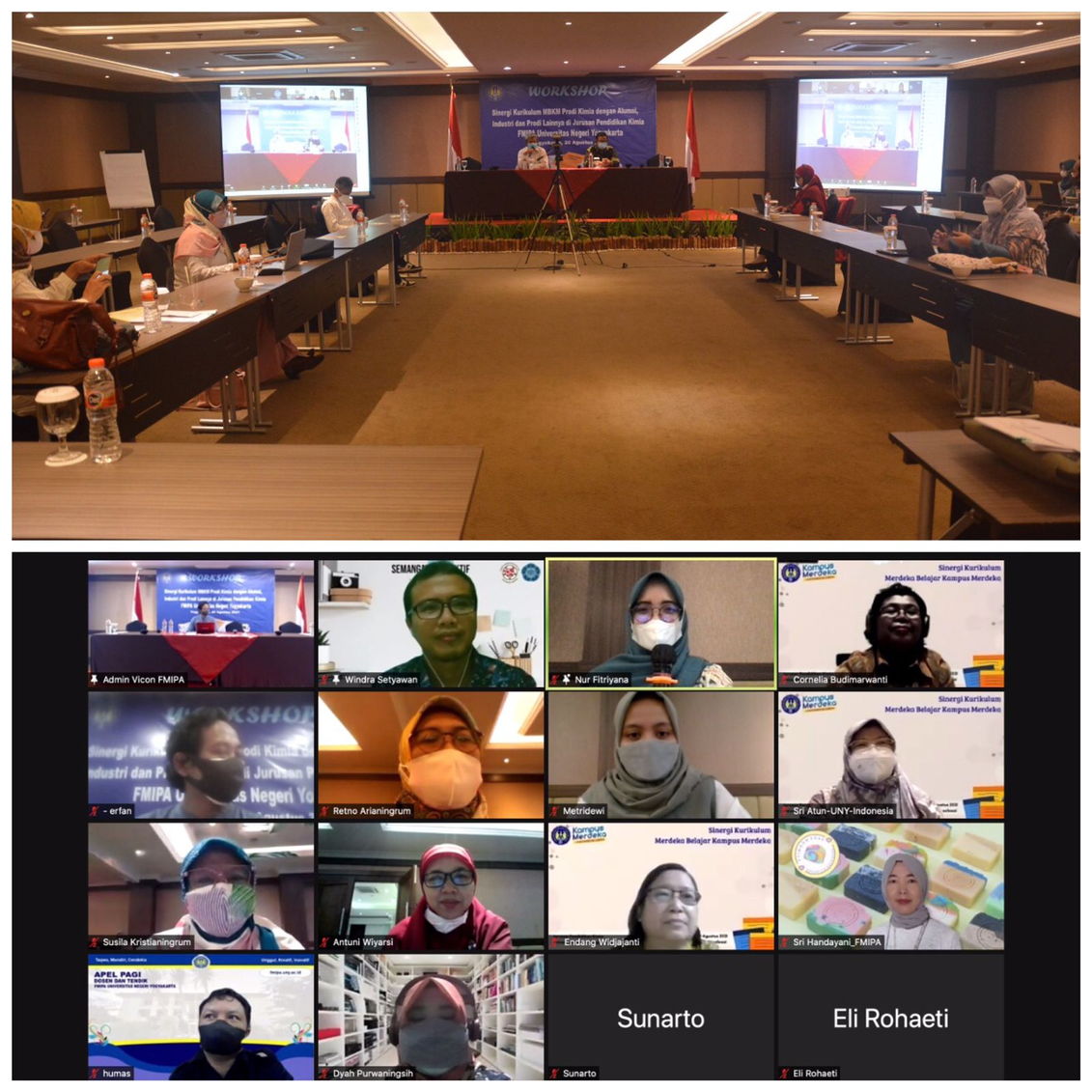You are here
Synergy of the Independent Learning Curriculum-Independent Campus

Chemistry study program, FMIPA, UNY held an Independent Learning Campus Curriculum Synergy (MBKM) activity on Friday, August 20, 2021 with the theme MBKM Curriculum Synergy for Chemistry Study Program with Alumni, Industry, and Other Study Programs at the Chemistry Education Department, FMIPA, UNY. The invited resource persons in this activity are (1) Dr. Maria Paristiowati from the formulation team for CPL Chemistry and Chemistry Education, Indonesian Chemical Association, (2) Dr. Harry Firman from the SEAQIS (SEAMEO QITEP in Science) expert team, and (3) Windra Setyawan, S.Si. who is an alumni of the chemistry study program who works at PT Esye Naturel Kosmetindo. This activity was attended by: (1) vice chancellor for academics, (2) dean of FMIPA UNY, (3) vice dean for academics and cooperation at FMIPA UNY, (4) vice dean for general and finance, FMIPA UNY, (5) program coordinator Study S-1 Chemistry, S-1 Chemistry Education, and S-2 Chemistry Education, (6) Independent Campus Competition Program taskforce, (7) Head of Expertise Group in Chemistry Education Department, FMIPA UNY, and (8) Education staff at FMIPA UNY.
This activity was divided into 2 sessions, the first session was led by Dr. Antuni Wiyarsi, M.Sc. In this first session, the presentation of the material was carried out by Dr. Maria Paristiowati and Dr. Harry Word. Dr. Maria delivered a presentation on synchronizing chemical content course material in the Chemistry S1 curriculum and Chemistry Education S1 curriculum. In his presentation, Dr. Maria said that the Learning Outcomes of Graduates (CPL) of the chemistry study program and chemistry education have differences, especially in their application in research. More specifically, the CPL relating to the basic courses between the Chemistry and Chemistry Education undergraduate study programs is the same. For example, in practicum activities, the provision of practicum between S1 Chemistry and S1 Chemistry Education study programs must be the same for basic practicums, for advanced practicums which will be different. For example, the Inorganic Chemistry 3 practicum is only given to Chemistry undergraduate students, not to Chemistry Education undergraduate students. The goal is to equip undergraduate students in Chemistry to become reliable researchers. For example, inorganic chemistry practicum 3 is not given in the chemistry education study program. Overall, the Bachelor of Chemistry curriculum with Bachelor of Chemistry Education Faculty of Mathematics and Natural Sciences UNY has an equivalent of 60-75% in terms of chemical content.
The event continued with a presentation by Dr. Harry Firman. Dr. Harry conveyed about the Implementation Issues of the Chemistry Education Master's Program at the Indonesian Education University. In his presentation, Dr. Harry explained that graduates of S1 Chemistry Education were prepared to become well prepared novice teachers of chemistry. The graduates of Master of Chemistry Education are prepared as expert teachers of chemistry. He also conveyed the basic differences between theses, theses, and dissertations from undergraduate, masters, and doctoral programs. The difference lies in the depth and complexity of each of the aspects discussed, especially aspects related to theory, research methods, and data exposure and analysis.
After the first session ended, the curriculum synergy event entered the second session led by Erfan Priyambodo, M.Sc. Windra Setyawan, S.Si. who is an alumni of the Chemistry Study Program, FMIPA UNY, delivered his presentation with the title Sharing Alumni and Synergy of Chemistry S1 Curriculum with Industry. In this session, Windra said that the theoretical content already in the Chemistry undergraduate curriculum is basically good, but practical support is needed on the operation of modern instruments that are often used in industry such as HPLC, AAS, etc. If this is not possible due to the unavailability of tools, then in lecture activities it is necessary to convey about how to operate these modern instruments and be equipped with video tutorials. As for the practicum activities, Windra Setyawan, S.Si. hope that the practical activities that support each theoretical lecture are up to date with current conditions.
Through this curriculum synergy activity, it is hoped that it can improve the quality of the curriculum of the existing study programs at the Department of Chemistry Education, Faculty of Mathematics and Natural Sciences, UNY, especially to bridge the gap between what is learned on campus and the real conditions in the industry.
Information System
Kontak Kami
Program Studi Kimia
FMIPA Universitas Negeri Yogyakarta
Kampus Karangmalang Yogyakarta 55281
Telp. (0274)586168 Pes. 115
Email: kimia@uny.ac.id atau s1kimia@uny.ac.id
Copyright © 2024,
